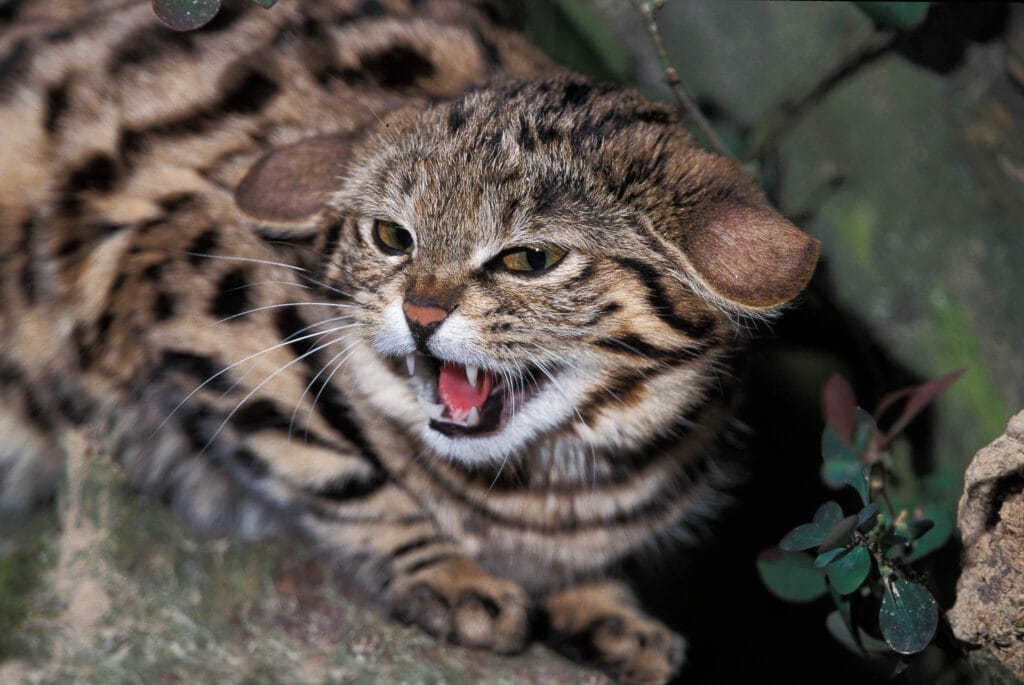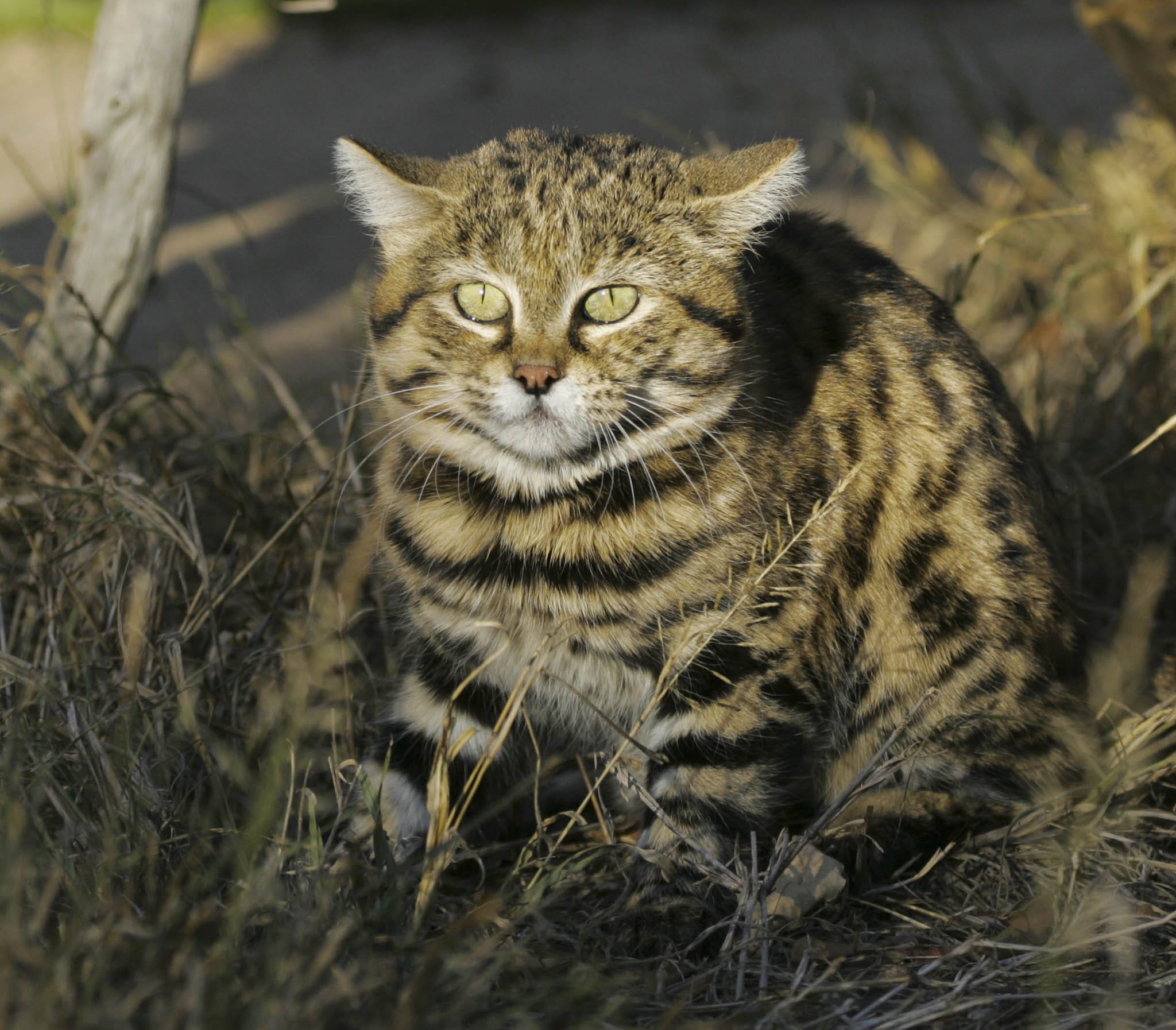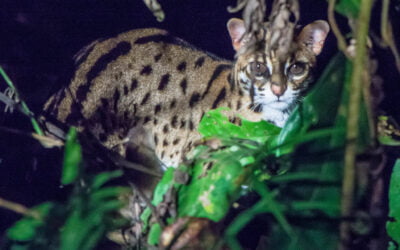Physical description of Black-footed Cats
Black-footed cats are one of the smallest of the cats. They are just a bit smaller than the sand cat, kodkod and flat-headed cats. They are about the same size as a Rusty-Spotted Cat.
Their light colored fur is patterned by black or brown spots. The face has stripes the same shade as the spots. These stripes are also often visible on the tail. The tail’s tip is black. Significantly, the color of the feet, like the tail tip, are noticeably black. Accordingly, this is where the common name is derived.
Distribution and habitat of Black-footed Cats
The Black-Footed Cat is at home in Southern Africa. It can be found in Botswana, Namibia, Zimbabwe and South Africa, living in the savanna that the region is renowned for.
Black-footed cats like grasslands and some arid areas such as deserts, or at least the transitional zones. They create dens underground, in small burrows, and are opportunistic in utilizing the holes of dug out termite mounds that have already been provided by Anteaters (and vacated by the termites).
Black-footed Cat behavior
The behavior of the black-footed cat is relatively solitary, seeking companionship only for mating, and when females are raising young.
Primarily nocturnal hunters, during the day, the cats shelter in their burrows or those of other animals, hidden from larger predators.
The males and females may share territory but rarely commingle. The male’s territory is significantly larger, perhaps almost twice the size of a female’s territory (10 sq km), and overlaps with multiple females. They mark territory with urine akin with many other cats.
Aforementioned, urine spraying and scent marking is predominantly a means of social communication of territory, and it also notifies males when a female is ready to breed.

What do Black-footed Cats eat?
The conventional diet of the black-footed cat is carnivorous, it correspondingly eats small animals, commonly birds and mammals. In rare circumstances, they will also prey on reptiles and invertebrates.
During the winter (dry season), when smaller food is scarce, they will prey on slightly larger animals and even hide the carcasses for future use.
Mating and Parental care of Black-footed Cats
The territories of males are more extensive and overlap that of the female black-footed cat. As such, males tend to mate with more than one female. Despite the overlapping territories, males and females don’t associate with each other except during mating. The female raises the cubs alone.
Black-footed cats tend to mate during the spring, and typically give birth at the start of the wetter season in Southern Africa. One or two kittens are born which are usually weaned by six weeks. It is towards the end of this stage that the young begin to hunt, and the female brings them live prey to feed upon, that is generally injured and easy to recapture. This assists the kittens in honing their skills.
Hunting is mostly done at night.
Who preys on Black-footed Cats
This is one of the luckiest cats when it comes to humans since it is not known to be hunted or persecuted by them. Their diminutive size prevents them from being a nuisance to livestock and the fur isn’t exploitable in comparison to larger animals.
Larger predators are a threat in their habitat, although given the nocturnal habits of the black-footed cat, we cannot specify the predating species. The infrequent sightings of the cats consequently affects observing others prey on them.
How long do Black-footed Cats live?
This is relatively unknown in the wild. Similar to other small cats, up to 15 years lifespan in captivity is common.
Black-footed Cats and their ecosystem
As a significant predator in its ecosystem, the black-footed cat is accountable for keeping the populations of smaller animals in check.
Impact of Black-footed Cats on the human economy
The black-footed cat curtails pests due to its predation on small rodents, which could carry disease. Smaller rodents can also be pests for crops, the cats to an extent provide a subtle positive economic impact.
There is no downside to a black-footed cat, with the exception of being scratched by them if you catch them unawares. Whilst the majority of larger cats don’t pose any risk to humans, they can be disruptive in areas with livestock. Black-footed cats are too small to cause disruption to the human economy.
Conservation status and human impact on Black-footed Cats
As previously mentioned, black-footed cats in general aren’t persecuted, but they are afflicted by poison and traps set for other animals. Hunting them is prohibited in South Africa (and Botswana, where hunting is illegal for everything).
The largest threat is the disruption to their habitat, be that from environmental damage or the fragmentation of their preferred habitat into smaller tracts of land.
Currently, they are found in many of South Africa’s National Parks, including Adoo Elephant NP, Karoo, and the Makgadikgadi NP in Botswana.










